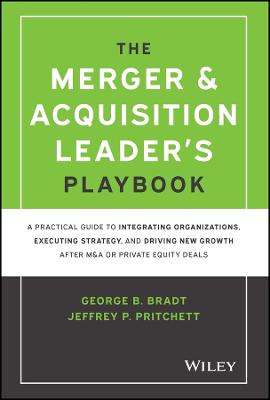Middle Market M & A
 -15%
portes grátis
-15%
portes grátis
Middle Market M & A
Handbook for Advisors, Investors, and Business Owners
Marks, Kenneth H.; Stewart, Thomas A.; Blees, Christian W.; Nall, Michael R.
John Wiley & Sons Inc
09/2022
496
Dura
Inglês
9781119828105
15 a 20 dias
866
Descrição não disponível.
Preface xxiii
Acknowledgments xxix
Part One Middle Market Overview 1
Chapter 1 The Middle Market 3
Performance and Impact 4
Definition 5
Characteristics of Middle Market Companies 7
Ownership 7
Access to and Use of Capital 8
Organization 8
Chapter 2 Private Capital Markets 11
Segmented Markets 12
How Market Players View Risk 17
Capital Providers 17
Owners' and Managers' Views of Risk/Return 18
Buyers 20
Market Activity 26
Chapter 3 Valuation Perspectives for the Private Markets 31
Private Business Valuation Can Be Viewed Through Different Standards of Value 32
Market Value 34
Investment Value 37
Fair Market Value 37
Fair Value 37
Incremental Business Value 38
Owner Value 38
LBO Value 39
Collateral Value 39
Book Value 39
Valuing Intangibles 39
Why the Different Versions of Value? 41
Valuation as a Range Concept 42
Value Worlds and Deals 43
Part Two For the Business Owner/Operator and Entrepreneur 45
Chapter 4 Transition, Succession, and Exit Planning 47
A Decision Framework 49
1. Owner Ambitions and Goals 50
2. Industry Cycle 51
3. Business Cycle 52
4. Company Foundation 53
A Team Approach 53
Chapter 5 Value Growth and Optimization 55
Increasing the Return on Invested Capital 57
Strategic Position 58
Customer Base 59
Cost Structure and Scalability 60
Working Capital 60
Human Capital 61
Reducing the Risk of Investment 62
Awareness and Planning 63
Growth Plans and Relative Position 63
Leadership Team 63
Predictability of Revenues and Earnings 65
Concentrations 65
Compliance 66
Keeping Current 67
Ease the Transfer of Ownership 67
Financial Information 68
Contracts 69
Title to Assets 69
Corporate Structure and Attributes 70
Don't Lose Focus on the Core Business 70
Summary 71
Formula Definitions 72
Part Three The M&A Practice and Processes 75
Chapter 6 Practice Management 77
Primary M&A Advisors 78
Marketing the M&A Practice 80
Target Audience 80
Networking 81
Marketing and Advertising 81
Pretransaction Consulting 82
Valuation Services 82
Other Consulting Services 82
Becoming an Expert 82
Client Acceptance 83
Confidentiality 84
Client Engagement 84
Identification of the Parties 85
Scope of Service 85
Limitations and Disclosures 86
Fees- Selling Advisor 86
Example Fee Structures 88
Termination and Tail 89
Buy-Side Engagements 89
Licensure Issues in the M&A Business 90
Chapter 7 Sell-Side Representation and Process 93
Selling Process Overview 93
Step 1: Preliminary Discussions with Seller 94
What Is the Transaction? 95
Value Expectations 95
Process 96
Step 2: Data Collection 97
Step 3: Industry Research and Identifying Buyers 100
Research Market Buyers 101
Step 4: The Marketing Book 101
Preparation 103
Seller Motivation 104
Financial Disclosures 105
Specific EBITDA Presentations 105
Balance Sheet Presentation 105
Other Financial Disclosures 106
Prospective Financial Presentation 106
Step 5: Marketing Process 106
Clear the List with the Seller 107
Initiate Contact with Buyers 107
Obtain Nondisclosure Agreements 108
Distribute the Book 108
Follow Up, Discuss, and Set Expectations 108
Step 6: The Auction Dynamic and Negotiations 109
Negotiated Sale 109
Private Auction 111
Public Auction 112
Step 7: Buyer Interest and Transaction Structure 113
Term Sheets 114
Indication of Interest (IOI) 114
Letters of Intent 114
Deal Structure 116
Asset versus Stock Structure 116
Other Tax Deferral Techniques 117
Step 8: Due Diligence 120
Step 9: Definitive Agreements 121
Step 10: Closing Process 122
Price and Valuation Changes 123
Terms and Conditions Changes 123
Third-Party Challenges 123
Allocation of Risk 124
Other Preclosing Mistakes 124
Postsale Integration 124
Chapter 8 Corporate Development and the Buy-Side Process 127
Why Acquire? 129
The Dismal Ds 130
Alternatives 131
The Acquisition Process 132
The Pipeline and Filter 133
Approaching the Target 134
The Balance between a Deep Dive and Locking In the Deal 135
Lower-Middle Market versus Middle Market Deals 136
Valuation from a Strategic's Perspective 137
Structuring the Transaction 140
The Bid 141
Due Diligence 141
Integration 144
Practical Tips and What Causes Deals to Fail 146
What Should We Acquire? 146
Why Are We Doing This? 147
Alignment of Interests 147
Recruit the Right Advisors Early 148
Allocate Enough Resources 148
Every Interaction Is a Negotiation 149
If It Can Go Wrong, It Will Go Wrong 149
Chapter 9 Buy-Side Representation 151
Buyer Clients 151
Strategy 152
The Filter 153
Financing 154
Quality of Earnings 154
Coordination 156
Integration 156
Chapter 10 Technology in the M&A Process 157
Virtual Data Room 158
Market Insight and Data 159
Deal Sourcing and Exchanges 162
Due Diligence Software 163
Project Management Software 164
Comprehensive M&A Software 164
Supporting Tools 165
Artificial Intelligence and Technology Trends 165
Technology Providers 167
Chapter 11 Professional Standards and Ethics 169
Holistic Advice 171
Ethical and Professional Standards 172
Competence and Professionalism (Reputation) 173
Best Practices (Activities) 173
Ethics (Behavioral Boundaries) 174
The Middle Market Standard 175
Part Four M&A Technical Discussions 177
Chapter 12 Financial Analysis 179
Financial Reporting Motivation 179
Ebitda 181
Balance Sheet Analysis 184
Working Capital 185
Normalization 190
Chapter 13 Market Valuation 195
Reasons for Appraisal 196
Determine the Value Subworld 196
Calculate the Benefit Stream 197
Synergies 203
Determine Private Return Expectation 205
Specific Investor Return 206
General Acquisition Selling Multiples 207
Derive Value 208
Chapter 14 Deal Structure 213
Structural Priorities 213
Business and Economic Terms 214
Tax Structure 218
Legal Structure 222
Mergers 224
Initial Analysis of Both Entities 224
Strategic Rationale 225
Valuation Modeling 225
Understanding Cost, Operational, and Cultural Differences 226
Developing the Integration Plan 227
Deal Structure and Negotiations 227
Chapter 15 Financing Sources and Capital Structure 229
Perspective 229
Financing Primer 230
Capital Structure 230
Factors Shaping the Capital Structure 234
Basic Deals 237
Buyouts 237
Recapitalizations 242
Acquisitions 243
Sources and Types of Funding 245
Debt 246
Private Equity 249
Personal Guarantees 250
Chapter 16 Due Diligence 255
Due Diligence Process 256
The Diligence Team 256
Traditional Due Diligence 257
Financial Matters 258
Quality of Earnings Analysis 258
Balance Sheet Analysis 260
Ratio Analysis 260
Other Risks 261
Audited Financial Statements 261
GAAP Compliance 262
Tax Structuring and Compliance 262
Compensation and Benefits 263
Legal 264
Technical Due Diligence 266
Business Due Diligence 267
Chapter 17 Tax Provisions Used in M&A 271
Tax Fundamentals 272
Transaction Tax Basics 275
Asset Transactions 275
Stock Transactions 277
Stock versus Asset Sale Example 278
Asset Transaction Details 280
Buyer Tax Issues 285
Detailed Tax Structuring 287
Installment Sales 287
Risk of Forfeiture 288
Assets That Qualify for Installment Treatment 288
Installment Planning Opportunity 289
Partnership M&A 289
General Partnership Doctrine 290
Partnership versus S Corporation 290
Partnership Gain Tracking Rules 292
Purchase Price Allocation for Partnership Buyers 293
Corporate M&A Issues 293
Contributions to Corporations 294
Stock/Asset Sale Election: Section 338 295
Mergers and Reorganizations 296
S Corporation Issues 300
Tax Glossary and Reference 302
Chapter 18 Legal Documentation 309
The Attorney's Role 309
Preliminary Legal Documents 311
Nondisclosure and Confidentiality Agreement 311
Letter of Intent 312
Acquisition Agreements 316
Structure of the Deal 316
Stock Sale/Merger 316
Asset Purchase 317
Representations and Warranties 318
Qualifications to Representations and Warranties 319
Indemnification 320
Transaction Statistics 321
Consulting and Employment Agreements 322
Regulatory Compliance 322
Chapter 19 Regulation and Compliance 323
Protecting Investors: Securities Act of 1933 324
Exemptions under the 33 Act 326
Commonly Used Private Placement Exemptions 327
Keeping The Markets Honest: Securities Exchange Act of 1934 329
Requirements and Rules 329
Williams Act 330
Antitrust Issues and Laws You May Encounter in the Deal 331
Hart-Scott-Rodino Act 332
Transactions Involving Foreign Investors, Foreign Trade, and National Defense Matters 333
Other Regulatory Issues and Laws You May Encounter in the Deal 334
Bulk Sales Laws 334
The WARN Act 335
The Investment Banker's Perspective 336
SEC Provisions Regulating Broker-Dealers 336
M&A Brokers No-Action Letter 338
Finders 344
Investment Advisers Act and Investment Company Act of 1940 345
FINRA Provisions for Broker-Dealers 347
The Company's Perspective 350
Process of Issuing, Selling, or Exchanging Securities for a Deal 351
State Blue-Sky Laws 354
Considerations for Public Companies 355
Chapter 20 Cross-Border Considerations 359
Is Cross-Border M&A the Right Move? 360
Culture 361
Country Risk 365
Financial Risk 365
Market and Operational Risks 367
The Legal Environment 367
Labor and Employment 370
Negotiations 371
Due Diligence 372
Integration 372
Summary 375
Glossary 377
Notes 417
About the Authors 423
About the Contributors and Reviewers 427
Index 445
Acknowledgments xxix
Part One Middle Market Overview 1
Chapter 1 The Middle Market 3
Performance and Impact 4
Definition 5
Characteristics of Middle Market Companies 7
Ownership 7
Access to and Use of Capital 8
Organization 8
Chapter 2 Private Capital Markets 11
Segmented Markets 12
How Market Players View Risk 17
Capital Providers 17
Owners' and Managers' Views of Risk/Return 18
Buyers 20
Market Activity 26
Chapter 3 Valuation Perspectives for the Private Markets 31
Private Business Valuation Can Be Viewed Through Different Standards of Value 32
Market Value 34
Investment Value 37
Fair Market Value 37
Fair Value 37
Incremental Business Value 38
Owner Value 38
LBO Value 39
Collateral Value 39
Book Value 39
Valuing Intangibles 39
Why the Different Versions of Value? 41
Valuation as a Range Concept 42
Value Worlds and Deals 43
Part Two For the Business Owner/Operator and Entrepreneur 45
Chapter 4 Transition, Succession, and Exit Planning 47
A Decision Framework 49
1. Owner Ambitions and Goals 50
2. Industry Cycle 51
3. Business Cycle 52
4. Company Foundation 53
A Team Approach 53
Chapter 5 Value Growth and Optimization 55
Increasing the Return on Invested Capital 57
Strategic Position 58
Customer Base 59
Cost Structure and Scalability 60
Working Capital 60
Human Capital 61
Reducing the Risk of Investment 62
Awareness and Planning 63
Growth Plans and Relative Position 63
Leadership Team 63
Predictability of Revenues and Earnings 65
Concentrations 65
Compliance 66
Keeping Current 67
Ease the Transfer of Ownership 67
Financial Information 68
Contracts 69
Title to Assets 69
Corporate Structure and Attributes 70
Don't Lose Focus on the Core Business 70
Summary 71
Formula Definitions 72
Part Three The M&A Practice and Processes 75
Chapter 6 Practice Management 77
Primary M&A Advisors 78
Marketing the M&A Practice 80
Target Audience 80
Networking 81
Marketing and Advertising 81
Pretransaction Consulting 82
Valuation Services 82
Other Consulting Services 82
Becoming an Expert 82
Client Acceptance 83
Confidentiality 84
Client Engagement 84
Identification of the Parties 85
Scope of Service 85
Limitations and Disclosures 86
Fees- Selling Advisor 86
Example Fee Structures 88
Termination and Tail 89
Buy-Side Engagements 89
Licensure Issues in the M&A Business 90
Chapter 7 Sell-Side Representation and Process 93
Selling Process Overview 93
Step 1: Preliminary Discussions with Seller 94
What Is the Transaction? 95
Value Expectations 95
Process 96
Step 2: Data Collection 97
Step 3: Industry Research and Identifying Buyers 100
Research Market Buyers 101
Step 4: The Marketing Book 101
Preparation 103
Seller Motivation 104
Financial Disclosures 105
Specific EBITDA Presentations 105
Balance Sheet Presentation 105
Other Financial Disclosures 106
Prospective Financial Presentation 106
Step 5: Marketing Process 106
Clear the List with the Seller 107
Initiate Contact with Buyers 107
Obtain Nondisclosure Agreements 108
Distribute the Book 108
Follow Up, Discuss, and Set Expectations 108
Step 6: The Auction Dynamic and Negotiations 109
Negotiated Sale 109
Private Auction 111
Public Auction 112
Step 7: Buyer Interest and Transaction Structure 113
Term Sheets 114
Indication of Interest (IOI) 114
Letters of Intent 114
Deal Structure 116
Asset versus Stock Structure 116
Other Tax Deferral Techniques 117
Step 8: Due Diligence 120
Step 9: Definitive Agreements 121
Step 10: Closing Process 122
Price and Valuation Changes 123
Terms and Conditions Changes 123
Third-Party Challenges 123
Allocation of Risk 124
Other Preclosing Mistakes 124
Postsale Integration 124
Chapter 8 Corporate Development and the Buy-Side Process 127
Why Acquire? 129
The Dismal Ds 130
Alternatives 131
The Acquisition Process 132
The Pipeline and Filter 133
Approaching the Target 134
The Balance between a Deep Dive and Locking In the Deal 135
Lower-Middle Market versus Middle Market Deals 136
Valuation from a Strategic's Perspective 137
Structuring the Transaction 140
The Bid 141
Due Diligence 141
Integration 144
Practical Tips and What Causes Deals to Fail 146
What Should We Acquire? 146
Why Are We Doing This? 147
Alignment of Interests 147
Recruit the Right Advisors Early 148
Allocate Enough Resources 148
Every Interaction Is a Negotiation 149
If It Can Go Wrong, It Will Go Wrong 149
Chapter 9 Buy-Side Representation 151
Buyer Clients 151
Strategy 152
The Filter 153
Financing 154
Quality of Earnings 154
Coordination 156
Integration 156
Chapter 10 Technology in the M&A Process 157
Virtual Data Room 158
Market Insight and Data 159
Deal Sourcing and Exchanges 162
Due Diligence Software 163
Project Management Software 164
Comprehensive M&A Software 164
Supporting Tools 165
Artificial Intelligence and Technology Trends 165
Technology Providers 167
Chapter 11 Professional Standards and Ethics 169
Holistic Advice 171
Ethical and Professional Standards 172
Competence and Professionalism (Reputation) 173
Best Practices (Activities) 173
Ethics (Behavioral Boundaries) 174
The Middle Market Standard 175
Part Four M&A Technical Discussions 177
Chapter 12 Financial Analysis 179
Financial Reporting Motivation 179
Ebitda 181
Balance Sheet Analysis 184
Working Capital 185
Normalization 190
Chapter 13 Market Valuation 195
Reasons for Appraisal 196
Determine the Value Subworld 196
Calculate the Benefit Stream 197
Synergies 203
Determine Private Return Expectation 205
Specific Investor Return 206
General Acquisition Selling Multiples 207
Derive Value 208
Chapter 14 Deal Structure 213
Structural Priorities 213
Business and Economic Terms 214
Tax Structure 218
Legal Structure 222
Mergers 224
Initial Analysis of Both Entities 224
Strategic Rationale 225
Valuation Modeling 225
Understanding Cost, Operational, and Cultural Differences 226
Developing the Integration Plan 227
Deal Structure and Negotiations 227
Chapter 15 Financing Sources and Capital Structure 229
Perspective 229
Financing Primer 230
Capital Structure 230
Factors Shaping the Capital Structure 234
Basic Deals 237
Buyouts 237
Recapitalizations 242
Acquisitions 243
Sources and Types of Funding 245
Debt 246
Private Equity 249
Personal Guarantees 250
Chapter 16 Due Diligence 255
Due Diligence Process 256
The Diligence Team 256
Traditional Due Diligence 257
Financial Matters 258
Quality of Earnings Analysis 258
Balance Sheet Analysis 260
Ratio Analysis 260
Other Risks 261
Audited Financial Statements 261
GAAP Compliance 262
Tax Structuring and Compliance 262
Compensation and Benefits 263
Legal 264
Technical Due Diligence 266
Business Due Diligence 267
Chapter 17 Tax Provisions Used in M&A 271
Tax Fundamentals 272
Transaction Tax Basics 275
Asset Transactions 275
Stock Transactions 277
Stock versus Asset Sale Example 278
Asset Transaction Details 280
Buyer Tax Issues 285
Detailed Tax Structuring 287
Installment Sales 287
Risk of Forfeiture 288
Assets That Qualify for Installment Treatment 288
Installment Planning Opportunity 289
Partnership M&A 289
General Partnership Doctrine 290
Partnership versus S Corporation 290
Partnership Gain Tracking Rules 292
Purchase Price Allocation for Partnership Buyers 293
Corporate M&A Issues 293
Contributions to Corporations 294
Stock/Asset Sale Election: Section 338 295
Mergers and Reorganizations 296
S Corporation Issues 300
Tax Glossary and Reference 302
Chapter 18 Legal Documentation 309
The Attorney's Role 309
Preliminary Legal Documents 311
Nondisclosure and Confidentiality Agreement 311
Letter of Intent 312
Acquisition Agreements 316
Structure of the Deal 316
Stock Sale/Merger 316
Asset Purchase 317
Representations and Warranties 318
Qualifications to Representations and Warranties 319
Indemnification 320
Transaction Statistics 321
Consulting and Employment Agreements 322
Regulatory Compliance 322
Chapter 19 Regulation and Compliance 323
Protecting Investors: Securities Act of 1933 324
Exemptions under the 33 Act 326
Commonly Used Private Placement Exemptions 327
Keeping The Markets Honest: Securities Exchange Act of 1934 329
Requirements and Rules 329
Williams Act 330
Antitrust Issues and Laws You May Encounter in the Deal 331
Hart-Scott-Rodino Act 332
Transactions Involving Foreign Investors, Foreign Trade, and National Defense Matters 333
Other Regulatory Issues and Laws You May Encounter in the Deal 334
Bulk Sales Laws 334
The WARN Act 335
The Investment Banker's Perspective 336
SEC Provisions Regulating Broker-Dealers 336
M&A Brokers No-Action Letter 338
Finders 344
Investment Advisers Act and Investment Company Act of 1940 345
FINRA Provisions for Broker-Dealers 347
The Company's Perspective 350
Process of Issuing, Selling, or Exchanging Securities for a Deal 351
State Blue-Sky Laws 354
Considerations for Public Companies 355
Chapter 20 Cross-Border Considerations 359
Is Cross-Border M&A the Right Move? 360
Culture 361
Country Risk 365
Financial Risk 365
Market and Operational Risks 367
The Legal Environment 367
Labor and Employment 370
Negotiations 371
Due Diligence 372
Integration 372
Summary 375
Glossary 377
Notes 417
About the Authors 423
About the Contributors and Reviewers 427
Index 445
Este título pertence ao(s) assunto(s) indicados(s). Para ver outros títulos clique no assunto desejado.
Mergers and acquisitions; mergers & acquisitions; m and a; strategic transactions; divestitures; pre-transaction m&a; post-transaction m&a; middle-market mergers; middle-market acquisitions; mid-market m&a; mid-market mergers; mid-market acquisitions; private equity; value growth; business sale; sell my business
Preface xxiii
Acknowledgments xxix
Part One Middle Market Overview 1
Chapter 1 The Middle Market 3
Performance and Impact 4
Definition 5
Characteristics of Middle Market Companies 7
Ownership 7
Access to and Use of Capital 8
Organization 8
Chapter 2 Private Capital Markets 11
Segmented Markets 12
How Market Players View Risk 17
Capital Providers 17
Owners' and Managers' Views of Risk/Return 18
Buyers 20
Market Activity 26
Chapter 3 Valuation Perspectives for the Private Markets 31
Private Business Valuation Can Be Viewed Through Different Standards of Value 32
Market Value 34
Investment Value 37
Fair Market Value 37
Fair Value 37
Incremental Business Value 38
Owner Value 38
LBO Value 39
Collateral Value 39
Book Value 39
Valuing Intangibles 39
Why the Different Versions of Value? 41
Valuation as a Range Concept 42
Value Worlds and Deals 43
Part Two For the Business Owner/Operator and Entrepreneur 45
Chapter 4 Transition, Succession, and Exit Planning 47
A Decision Framework 49
1. Owner Ambitions and Goals 50
2. Industry Cycle 51
3. Business Cycle 52
4. Company Foundation 53
A Team Approach 53
Chapter 5 Value Growth and Optimization 55
Increasing the Return on Invested Capital 57
Strategic Position 58
Customer Base 59
Cost Structure and Scalability 60
Working Capital 60
Human Capital 61
Reducing the Risk of Investment 62
Awareness and Planning 63
Growth Plans and Relative Position 63
Leadership Team 63
Predictability of Revenues and Earnings 65
Concentrations 65
Compliance 66
Keeping Current 67
Ease the Transfer of Ownership 67
Financial Information 68
Contracts 69
Title to Assets 69
Corporate Structure and Attributes 70
Don't Lose Focus on the Core Business 70
Summary 71
Formula Definitions 72
Part Three The M&A Practice and Processes 75
Chapter 6 Practice Management 77
Primary M&A Advisors 78
Marketing the M&A Practice 80
Target Audience 80
Networking 81
Marketing and Advertising 81
Pretransaction Consulting 82
Valuation Services 82
Other Consulting Services 82
Becoming an Expert 82
Client Acceptance 83
Confidentiality 84
Client Engagement 84
Identification of the Parties 85
Scope of Service 85
Limitations and Disclosures 86
Fees- Selling Advisor 86
Example Fee Structures 88
Termination and Tail 89
Buy-Side Engagements 89
Licensure Issues in the M&A Business 90
Chapter 7 Sell-Side Representation and Process 93
Selling Process Overview 93
Step 1: Preliminary Discussions with Seller 94
What Is the Transaction? 95
Value Expectations 95
Process 96
Step 2: Data Collection 97
Step 3: Industry Research and Identifying Buyers 100
Research Market Buyers 101
Step 4: The Marketing Book 101
Preparation 103
Seller Motivation 104
Financial Disclosures 105
Specific EBITDA Presentations 105
Balance Sheet Presentation 105
Other Financial Disclosures 106
Prospective Financial Presentation 106
Step 5: Marketing Process 106
Clear the List with the Seller 107
Initiate Contact with Buyers 107
Obtain Nondisclosure Agreements 108
Distribute the Book 108
Follow Up, Discuss, and Set Expectations 108
Step 6: The Auction Dynamic and Negotiations 109
Negotiated Sale 109
Private Auction 111
Public Auction 112
Step 7: Buyer Interest and Transaction Structure 113
Term Sheets 114
Indication of Interest (IOI) 114
Letters of Intent 114
Deal Structure 116
Asset versus Stock Structure 116
Other Tax Deferral Techniques 117
Step 8: Due Diligence 120
Step 9: Definitive Agreements 121
Step 10: Closing Process 122
Price and Valuation Changes 123
Terms and Conditions Changes 123
Third-Party Challenges 123
Allocation of Risk 124
Other Preclosing Mistakes 124
Postsale Integration 124
Chapter 8 Corporate Development and the Buy-Side Process 127
Why Acquire? 129
The Dismal Ds 130
Alternatives 131
The Acquisition Process 132
The Pipeline and Filter 133
Approaching the Target 134
The Balance between a Deep Dive and Locking In the Deal 135
Lower-Middle Market versus Middle Market Deals 136
Valuation from a Strategic's Perspective 137
Structuring the Transaction 140
The Bid 141
Due Diligence 141
Integration 144
Practical Tips and What Causes Deals to Fail 146
What Should We Acquire? 146
Why Are We Doing This? 147
Alignment of Interests 147
Recruit the Right Advisors Early 148
Allocate Enough Resources 148
Every Interaction Is a Negotiation 149
If It Can Go Wrong, It Will Go Wrong 149
Chapter 9 Buy-Side Representation 151
Buyer Clients 151
Strategy 152
The Filter 153
Financing 154
Quality of Earnings 154
Coordination 156
Integration 156
Chapter 10 Technology in the M&A Process 157
Virtual Data Room 158
Market Insight and Data 159
Deal Sourcing and Exchanges 162
Due Diligence Software 163
Project Management Software 164
Comprehensive M&A Software 164
Supporting Tools 165
Artificial Intelligence and Technology Trends 165
Technology Providers 167
Chapter 11 Professional Standards and Ethics 169
Holistic Advice 171
Ethical and Professional Standards 172
Competence and Professionalism (Reputation) 173
Best Practices (Activities) 173
Ethics (Behavioral Boundaries) 174
The Middle Market Standard 175
Part Four M&A Technical Discussions 177
Chapter 12 Financial Analysis 179
Financial Reporting Motivation 179
Ebitda 181
Balance Sheet Analysis 184
Working Capital 185
Normalization 190
Chapter 13 Market Valuation 195
Reasons for Appraisal 196
Determine the Value Subworld 196
Calculate the Benefit Stream 197
Synergies 203
Determine Private Return Expectation 205
Specific Investor Return 206
General Acquisition Selling Multiples 207
Derive Value 208
Chapter 14 Deal Structure 213
Structural Priorities 213
Business and Economic Terms 214
Tax Structure 218
Legal Structure 222
Mergers 224
Initial Analysis of Both Entities 224
Strategic Rationale 225
Valuation Modeling 225
Understanding Cost, Operational, and Cultural Differences 226
Developing the Integration Plan 227
Deal Structure and Negotiations 227
Chapter 15 Financing Sources and Capital Structure 229
Perspective 229
Financing Primer 230
Capital Structure 230
Factors Shaping the Capital Structure 234
Basic Deals 237
Buyouts 237
Recapitalizations 242
Acquisitions 243
Sources and Types of Funding 245
Debt 246
Private Equity 249
Personal Guarantees 250
Chapter 16 Due Diligence 255
Due Diligence Process 256
The Diligence Team 256
Traditional Due Diligence 257
Financial Matters 258
Quality of Earnings Analysis 258
Balance Sheet Analysis 260
Ratio Analysis 260
Other Risks 261
Audited Financial Statements 261
GAAP Compliance 262
Tax Structuring and Compliance 262
Compensation and Benefits 263
Legal 264
Technical Due Diligence 266
Business Due Diligence 267
Chapter 17 Tax Provisions Used in M&A 271
Tax Fundamentals 272
Transaction Tax Basics 275
Asset Transactions 275
Stock Transactions 277
Stock versus Asset Sale Example 278
Asset Transaction Details 280
Buyer Tax Issues 285
Detailed Tax Structuring 287
Installment Sales 287
Risk of Forfeiture 288
Assets That Qualify for Installment Treatment 288
Installment Planning Opportunity 289
Partnership M&A 289
General Partnership Doctrine 290
Partnership versus S Corporation 290
Partnership Gain Tracking Rules 292
Purchase Price Allocation for Partnership Buyers 293
Corporate M&A Issues 293
Contributions to Corporations 294
Stock/Asset Sale Election: Section 338 295
Mergers and Reorganizations 296
S Corporation Issues 300
Tax Glossary and Reference 302
Chapter 18 Legal Documentation 309
The Attorney's Role 309
Preliminary Legal Documents 311
Nondisclosure and Confidentiality Agreement 311
Letter of Intent 312
Acquisition Agreements 316
Structure of the Deal 316
Stock Sale/Merger 316
Asset Purchase 317
Representations and Warranties 318
Qualifications to Representations and Warranties 319
Indemnification 320
Transaction Statistics 321
Consulting and Employment Agreements 322
Regulatory Compliance 322
Chapter 19 Regulation and Compliance 323
Protecting Investors: Securities Act of 1933 324
Exemptions under the 33 Act 326
Commonly Used Private Placement Exemptions 327
Keeping The Markets Honest: Securities Exchange Act of 1934 329
Requirements and Rules 329
Williams Act 330
Antitrust Issues and Laws You May Encounter in the Deal 331
Hart-Scott-Rodino Act 332
Transactions Involving Foreign Investors, Foreign Trade, and National Defense Matters 333
Other Regulatory Issues and Laws You May Encounter in the Deal 334
Bulk Sales Laws 334
The WARN Act 335
The Investment Banker's Perspective 336
SEC Provisions Regulating Broker-Dealers 336
M&A Brokers No-Action Letter 338
Finders 344
Investment Advisers Act and Investment Company Act of 1940 345
FINRA Provisions for Broker-Dealers 347
The Company's Perspective 350
Process of Issuing, Selling, or Exchanging Securities for a Deal 351
State Blue-Sky Laws 354
Considerations for Public Companies 355
Chapter 20 Cross-Border Considerations 359
Is Cross-Border M&A the Right Move? 360
Culture 361
Country Risk 365
Financial Risk 365
Market and Operational Risks 367
The Legal Environment 367
Labor and Employment 370
Negotiations 371
Due Diligence 372
Integration 372
Summary 375
Glossary 377
Notes 417
About the Authors 423
About the Contributors and Reviewers 427
Index 445
Acknowledgments xxix
Part One Middle Market Overview 1
Chapter 1 The Middle Market 3
Performance and Impact 4
Definition 5
Characteristics of Middle Market Companies 7
Ownership 7
Access to and Use of Capital 8
Organization 8
Chapter 2 Private Capital Markets 11
Segmented Markets 12
How Market Players View Risk 17
Capital Providers 17
Owners' and Managers' Views of Risk/Return 18
Buyers 20
Market Activity 26
Chapter 3 Valuation Perspectives for the Private Markets 31
Private Business Valuation Can Be Viewed Through Different Standards of Value 32
Market Value 34
Investment Value 37
Fair Market Value 37
Fair Value 37
Incremental Business Value 38
Owner Value 38
LBO Value 39
Collateral Value 39
Book Value 39
Valuing Intangibles 39
Why the Different Versions of Value? 41
Valuation as a Range Concept 42
Value Worlds and Deals 43
Part Two For the Business Owner/Operator and Entrepreneur 45
Chapter 4 Transition, Succession, and Exit Planning 47
A Decision Framework 49
1. Owner Ambitions and Goals 50
2. Industry Cycle 51
3. Business Cycle 52
4. Company Foundation 53
A Team Approach 53
Chapter 5 Value Growth and Optimization 55
Increasing the Return on Invested Capital 57
Strategic Position 58
Customer Base 59
Cost Structure and Scalability 60
Working Capital 60
Human Capital 61
Reducing the Risk of Investment 62
Awareness and Planning 63
Growth Plans and Relative Position 63
Leadership Team 63
Predictability of Revenues and Earnings 65
Concentrations 65
Compliance 66
Keeping Current 67
Ease the Transfer of Ownership 67
Financial Information 68
Contracts 69
Title to Assets 69
Corporate Structure and Attributes 70
Don't Lose Focus on the Core Business 70
Summary 71
Formula Definitions 72
Part Three The M&A Practice and Processes 75
Chapter 6 Practice Management 77
Primary M&A Advisors 78
Marketing the M&A Practice 80
Target Audience 80
Networking 81
Marketing and Advertising 81
Pretransaction Consulting 82
Valuation Services 82
Other Consulting Services 82
Becoming an Expert 82
Client Acceptance 83
Confidentiality 84
Client Engagement 84
Identification of the Parties 85
Scope of Service 85
Limitations and Disclosures 86
Fees- Selling Advisor 86
Example Fee Structures 88
Termination and Tail 89
Buy-Side Engagements 89
Licensure Issues in the M&A Business 90
Chapter 7 Sell-Side Representation and Process 93
Selling Process Overview 93
Step 1: Preliminary Discussions with Seller 94
What Is the Transaction? 95
Value Expectations 95
Process 96
Step 2: Data Collection 97
Step 3: Industry Research and Identifying Buyers 100
Research Market Buyers 101
Step 4: The Marketing Book 101
Preparation 103
Seller Motivation 104
Financial Disclosures 105
Specific EBITDA Presentations 105
Balance Sheet Presentation 105
Other Financial Disclosures 106
Prospective Financial Presentation 106
Step 5: Marketing Process 106
Clear the List with the Seller 107
Initiate Contact with Buyers 107
Obtain Nondisclosure Agreements 108
Distribute the Book 108
Follow Up, Discuss, and Set Expectations 108
Step 6: The Auction Dynamic and Negotiations 109
Negotiated Sale 109
Private Auction 111
Public Auction 112
Step 7: Buyer Interest and Transaction Structure 113
Term Sheets 114
Indication of Interest (IOI) 114
Letters of Intent 114
Deal Structure 116
Asset versus Stock Structure 116
Other Tax Deferral Techniques 117
Step 8: Due Diligence 120
Step 9: Definitive Agreements 121
Step 10: Closing Process 122
Price and Valuation Changes 123
Terms and Conditions Changes 123
Third-Party Challenges 123
Allocation of Risk 124
Other Preclosing Mistakes 124
Postsale Integration 124
Chapter 8 Corporate Development and the Buy-Side Process 127
Why Acquire? 129
The Dismal Ds 130
Alternatives 131
The Acquisition Process 132
The Pipeline and Filter 133
Approaching the Target 134
The Balance between a Deep Dive and Locking In the Deal 135
Lower-Middle Market versus Middle Market Deals 136
Valuation from a Strategic's Perspective 137
Structuring the Transaction 140
The Bid 141
Due Diligence 141
Integration 144
Practical Tips and What Causes Deals to Fail 146
What Should We Acquire? 146
Why Are We Doing This? 147
Alignment of Interests 147
Recruit the Right Advisors Early 148
Allocate Enough Resources 148
Every Interaction Is a Negotiation 149
If It Can Go Wrong, It Will Go Wrong 149
Chapter 9 Buy-Side Representation 151
Buyer Clients 151
Strategy 152
The Filter 153
Financing 154
Quality of Earnings 154
Coordination 156
Integration 156
Chapter 10 Technology in the M&A Process 157
Virtual Data Room 158
Market Insight and Data 159
Deal Sourcing and Exchanges 162
Due Diligence Software 163
Project Management Software 164
Comprehensive M&A Software 164
Supporting Tools 165
Artificial Intelligence and Technology Trends 165
Technology Providers 167
Chapter 11 Professional Standards and Ethics 169
Holistic Advice 171
Ethical and Professional Standards 172
Competence and Professionalism (Reputation) 173
Best Practices (Activities) 173
Ethics (Behavioral Boundaries) 174
The Middle Market Standard 175
Part Four M&A Technical Discussions 177
Chapter 12 Financial Analysis 179
Financial Reporting Motivation 179
Ebitda 181
Balance Sheet Analysis 184
Working Capital 185
Normalization 190
Chapter 13 Market Valuation 195
Reasons for Appraisal 196
Determine the Value Subworld 196
Calculate the Benefit Stream 197
Synergies 203
Determine Private Return Expectation 205
Specific Investor Return 206
General Acquisition Selling Multiples 207
Derive Value 208
Chapter 14 Deal Structure 213
Structural Priorities 213
Business and Economic Terms 214
Tax Structure 218
Legal Structure 222
Mergers 224
Initial Analysis of Both Entities 224
Strategic Rationale 225
Valuation Modeling 225
Understanding Cost, Operational, and Cultural Differences 226
Developing the Integration Plan 227
Deal Structure and Negotiations 227
Chapter 15 Financing Sources and Capital Structure 229
Perspective 229
Financing Primer 230
Capital Structure 230
Factors Shaping the Capital Structure 234
Basic Deals 237
Buyouts 237
Recapitalizations 242
Acquisitions 243
Sources and Types of Funding 245
Debt 246
Private Equity 249
Personal Guarantees 250
Chapter 16 Due Diligence 255
Due Diligence Process 256
The Diligence Team 256
Traditional Due Diligence 257
Financial Matters 258
Quality of Earnings Analysis 258
Balance Sheet Analysis 260
Ratio Analysis 260
Other Risks 261
Audited Financial Statements 261
GAAP Compliance 262
Tax Structuring and Compliance 262
Compensation and Benefits 263
Legal 264
Technical Due Diligence 266
Business Due Diligence 267
Chapter 17 Tax Provisions Used in M&A 271
Tax Fundamentals 272
Transaction Tax Basics 275
Asset Transactions 275
Stock Transactions 277
Stock versus Asset Sale Example 278
Asset Transaction Details 280
Buyer Tax Issues 285
Detailed Tax Structuring 287
Installment Sales 287
Risk of Forfeiture 288
Assets That Qualify for Installment Treatment 288
Installment Planning Opportunity 289
Partnership M&A 289
General Partnership Doctrine 290
Partnership versus S Corporation 290
Partnership Gain Tracking Rules 292
Purchase Price Allocation for Partnership Buyers 293
Corporate M&A Issues 293
Contributions to Corporations 294
Stock/Asset Sale Election: Section 338 295
Mergers and Reorganizations 296
S Corporation Issues 300
Tax Glossary and Reference 302
Chapter 18 Legal Documentation 309
The Attorney's Role 309
Preliminary Legal Documents 311
Nondisclosure and Confidentiality Agreement 311
Letter of Intent 312
Acquisition Agreements 316
Structure of the Deal 316
Stock Sale/Merger 316
Asset Purchase 317
Representations and Warranties 318
Qualifications to Representations and Warranties 319
Indemnification 320
Transaction Statistics 321
Consulting and Employment Agreements 322
Regulatory Compliance 322
Chapter 19 Regulation and Compliance 323
Protecting Investors: Securities Act of 1933 324
Exemptions under the 33 Act 326
Commonly Used Private Placement Exemptions 327
Keeping The Markets Honest: Securities Exchange Act of 1934 329
Requirements and Rules 329
Williams Act 330
Antitrust Issues and Laws You May Encounter in the Deal 331
Hart-Scott-Rodino Act 332
Transactions Involving Foreign Investors, Foreign Trade, and National Defense Matters 333
Other Regulatory Issues and Laws You May Encounter in the Deal 334
Bulk Sales Laws 334
The WARN Act 335
The Investment Banker's Perspective 336
SEC Provisions Regulating Broker-Dealers 336
M&A Brokers No-Action Letter 338
Finders 344
Investment Advisers Act and Investment Company Act of 1940 345
FINRA Provisions for Broker-Dealers 347
The Company's Perspective 350
Process of Issuing, Selling, or Exchanging Securities for a Deal 351
State Blue-Sky Laws 354
Considerations for Public Companies 355
Chapter 20 Cross-Border Considerations 359
Is Cross-Border M&A the Right Move? 360
Culture 361
Country Risk 365
Financial Risk 365
Market and Operational Risks 367
The Legal Environment 367
Labor and Employment 370
Negotiations 371
Due Diligence 372
Integration 372
Summary 375
Glossary 377
Notes 417
About the Authors 423
About the Contributors and Reviewers 427
Index 445
Este título pertence ao(s) assunto(s) indicados(s). Para ver outros títulos clique no assunto desejado.
Mergers and acquisitions; mergers & acquisitions; m and a; strategic transactions; divestitures; pre-transaction m&a; post-transaction m&a; middle-market mergers; middle-market acquisitions; mid-market m&a; mid-market mergers; mid-market acquisitions; private equity; value growth; business sale; sell my business







